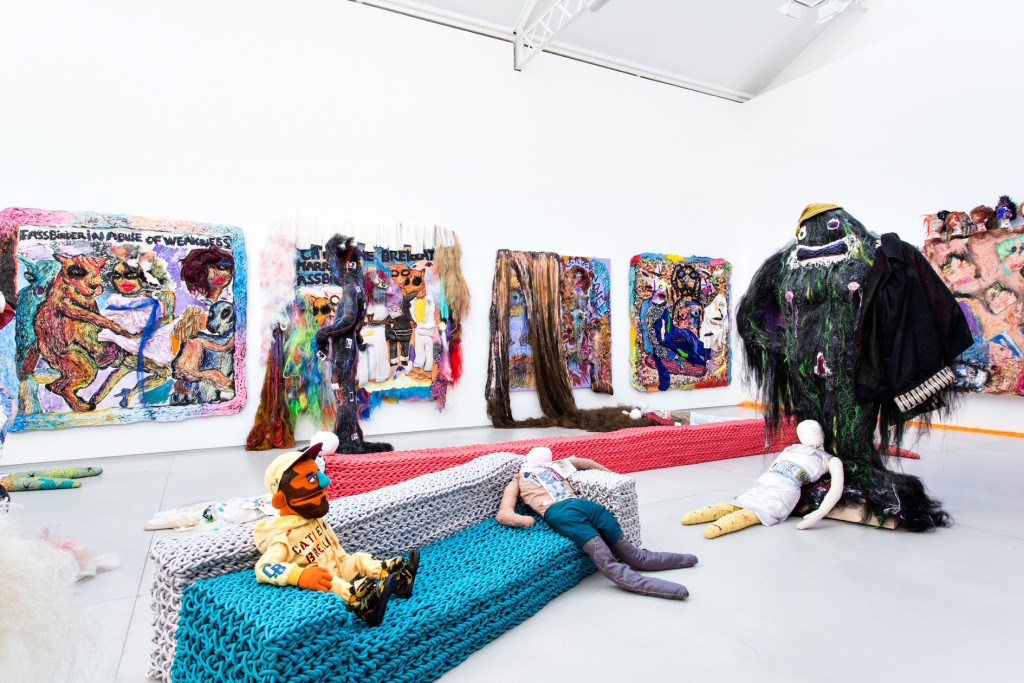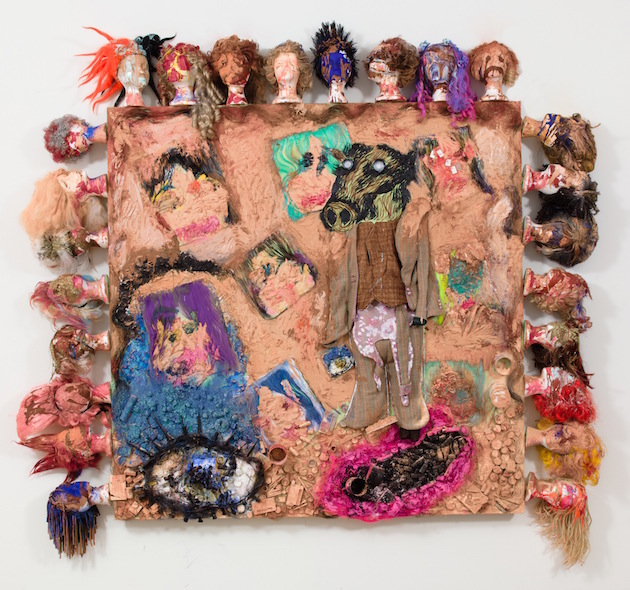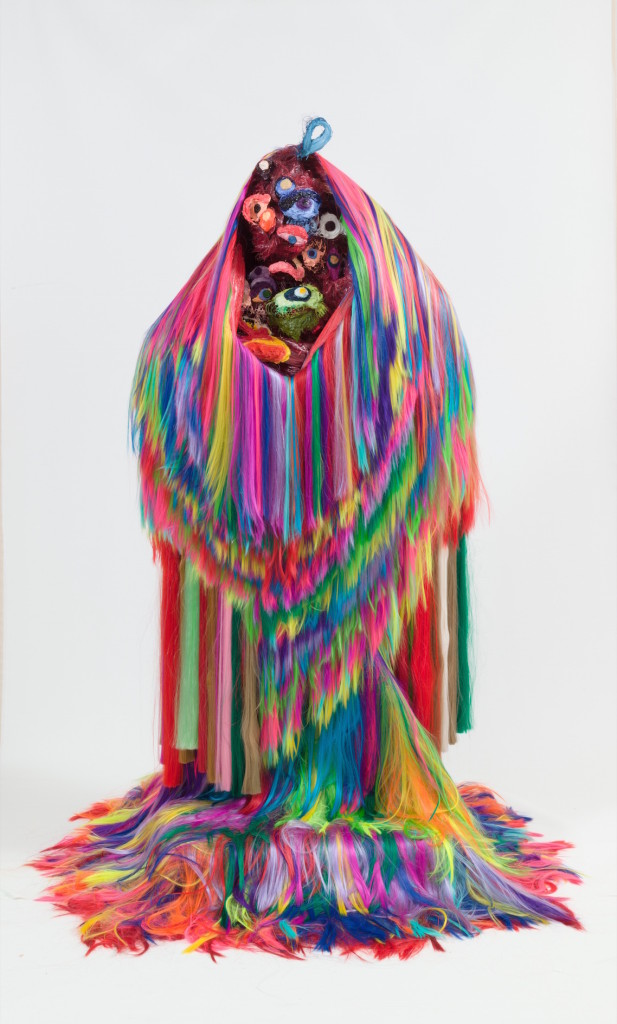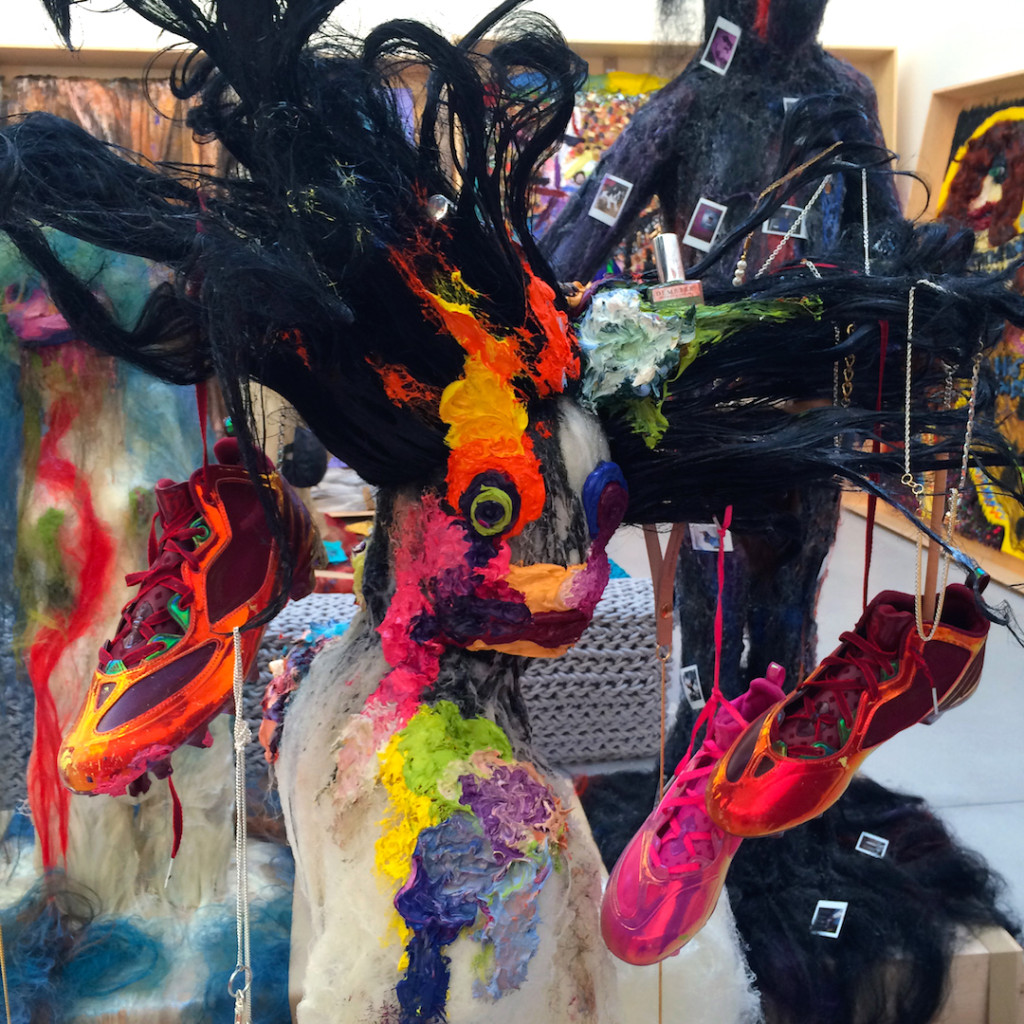
Bjarne Melgaard, Installation view, “The Casual Pleasure of Disappointment”, 2015, Courtesy Galerie Thaddaeus Ropac, Paris, Photos: Jason Mandella
The art world is being rocked by Bjarne Melgaard. After an exhibition that opened at the Munch Museum in Oslo on January 31st, the artist opened yet another in Paris at Galerie Thaddaeus Ropac. Titled “The Casual Pleasure of Disappointment”, it is his first with the gallery. As one of Norway’s most globally visible contemporary artists, Melgaard has a unique way of looking at the world and often collaborates with other artists, who function as another medium in his practice. Not long ago, he met hairdresser and artist Bob Recine in New York and a magical collaboration was formed. Both men are headstrong, disciplined and very specific in their respective visions. Fortunately, they each allowed the others intuition to remain unfeigned and what resulted in one unique room at the Munch Museum and the entire interior of Galerie Thaddaeus Ropac is a polychromatic environment of various media and energies. What Bob Recine brought to these two exhibitions is what he does best; hair as sculpture.

Bjarne Melgaard with Bob Recine and Andre Walker, Untitled, 2015, Oil on canvas and mixed media (synthetic hair, resin, styrofoam heads, makeup), Courtesy Galerie Thaddaeus Ropac, Paris, Photos: Jason Mandella
KATY DIAMOND HAMER: You worked with Bjarne Melgaard in Oslo at the Munch Museum and now in the show at Galerie Thaddeus Ropac. What can you say about your involvement in each respective show as an artist yourself?
BOB RECINE: For the show in Oslo, Bjarne had an idea with [life-size] dolls whose form is modeled after his own body. His original conception around the beauty and the image of the dolls seemed a bit weak, so I said, if you’d like me to do something what we need to do is work on the dolls. I did the image for these figures. I have to say, I was a little shocked because the paintings were so beautiful and refined and the dolls covered most of their surfaces. Bjarne got a kick out of this.
KDH: Collaboration isn’t new for you since you’ve worked with people such as Richard Avedon, Helmut Newton, and frequently with Mario Sorrenti. What can you say about your collaboration with Bjarne Melgaard?
BR: People might ask, “What do you mean you’re a hairdresser? What do you mean you’re working with Bjarne?” For some strange reason people get confused but I’ve been used to that my whole life. My book, “Alchemy of Beauty” (published by Freedman|Damiani, 2012) visually describes collaborations with [artists such as] Louise Bourgeois, Vanessa Beecroft and others. It explains a lot.
KDH: Can you talk about the decision to put images of your abstract, non-narrative paintings next to photographs of figures, where the focus is on the hair in various pages in the book?
BR: You know, people said, you can’t do that. The juxtapositions and even opposites if you will, that I’ve done, that Bjarne is doing, are the same thing. That’s the beauty of me and Bjarne, he gets that in me and I get that in him. He has his hands in a lot of things now and it makes complete sense to me! His figurative (sculptural) silhouettes and his attitude is something. At the opening in Paris, I said to Bjarne, “What do you want me to do?” And he replied, “Whatever the fuck you want to do.” Our principles are the same.
While in Paris, I was asked about the collectors and how they are expected to deal with all the hair −a train 40 or 50 feet in length going halfway around the gallery− coming off a beautiful painting. I felt that collectors might be interested in this extension, and for those who are not, I believe that they should just cut it off. I like hair, and I like cutting it off. There is that ephemeral part of me that one might call the “hairdresser” which is an extension of myself and my mind that has an understanding of hair, even if it is attached to a painting; Cut it off!

Bjarne Melgaard with Bob Recine, Untitled, 2015 Mixed media (synthetic hair, resin, plastic, oil paint), Courtesy Galerie Thaddaeus Ropac, Paris, Photos: Jason Mandella
KDH: What was it like working with Louise Bourgeois?
BR: We met because I was working with her on a portrait for Vogue magazine. Louise walked into the room and said, “Who is Bob Recine?” and I said, “That’s me” and she replied, “You’re the most important person here. You’re the only person that actually makes something.” And I said, “Thank you.” At the time, she really didn’t have much hair and I made her an elaborate hair style/piece, that really became in a sense her later signature. I think she and others understood that I was more of a sculptor or designer. The hairdressing part was easy. Flirting with girls, and Louise was the same. I didn’t overpower her sense of beauty or presence. We later collaborated on a charity event and a few other things, two alchemists recognizing each other, a great, great lady.
KDH: You were born and raised in Manhattan. How did you get your start in the hair industry?
BR: Andy Warhol was a mentor to me and many other teenagers at the time. We all wanted to show him pictures that we drew and he would listen and be interested in a real and sincere way. You could be in a room with Andy and a hundred screaming people and feel like it was just you and him. He had a very intimate presence. I would see how he would introduce people, he was always crisscrossing things. One day he sent me to see a woman, he said, “Go here Bob and show her your drawings. Show somebody else what you are showing me.” I went to Henri Bendel on 57th Street to see Geraldine Stutz, and I walked in on a meeting between her and the famous Jean Louis David who was opening his first salon in New York at Bendel’s. He and my girlfriend at the time went off while Stutz and I spoke. Mister David came back into the room and asked if I was a hairdresser and I said “No,” then he asked if I cut my girlfriends hair and I said, “Yes.” In the those days, you had to fuck up your hair by yourself, there wasn’t anyone [professionally] who could do it for you and give you a punk rock look. There wasn’t a salon to go to. He asked if I wanted to be a hairdresser and I said, “No, thank you very much.” Andy later said, “This guy thought you were interesting. You should consider this. He’s an artist.” This I found confusing since I didn’t know if it was Andy’s way of being puzzling by merging hairdresser and artist, but I was offered a free trip to Europe, my first at the time being 19 or 20 years old, and I took it. Fast forward and Vogue Magazine has called me one of the top five in the world in what I do.
KDH: How was it working with Lady Gaga?
BR: Well, in a certain sense, Gaga is a perfect girl for me. Here is someone who wants to take chances and is ready to hit the bullseye or miss the whole fucking target. Warhol told me something that always resonates in my mind, “What people don’t understand today, use that as your guide because that’s what will be [the art of] tomorrow. If you can’t understand it, latch onto it.” I think that was his understanding of art and personalities. Coming back to Bjarne, as with Gaga, there is a shared level of principles and understanding.

Bjarne Melgaard, Detailed Installation view “The Casual Pleasure of Disappointment”, Courtesy Galerie Thaddaeus Ropac, Paris, Photos: Jason Mandella
KDH: Would you say that there is a moment in the span of your career that stands out?
BR: A perspective on life on what I do is key. Once I do something, even such as the paintings with Bjarne, it’s over. When working with photographers I don’t need to look at the magazines. I understand myself enough to know that the real moment, is the moment. My whole interest in working with Bjarne was to go beyond anything I’ve ever done before. I have a tendency not to reminisce, in a certain sense, I like to destroy it in myself by going beyond it.
KDH: So in a way it sounds like meeting him was perfect timing, Kismet.
BR: I took three months off to do this project. I knew I had a great opportunity to do something special, and as I mentioned I think Bjarne also recognized that very early on as well. An artist needs to take chances in order to move forward. To modernize, to revolutionize, to move forward, to controversial moments, to make mistakes, that is one of the secrets I have to create anything. It’s all about going beyond, getting mucked up and then finding out what you need on your way home.
KDH: I think some of the best artists are like that, where they have this intuitive quality about them, to make, to do, and they don’t need to see what other people are doing.
BR: It’s very easy to say, but it’s all a matter of time. And I do enjoy those rare moments when I get to see a show or other people’s works, but it’s not a passion of mine. It was a passion of mine as a teenager just finding out who I was in this world…
KDH: Developing your tastes, and now?
BR: I’m not on Facebook or Instagram and once I discovered that age of information, I didn’t need it. I had all my sources of where to get information, inspiration, poison, health and social media was just something that was in the way for me. At this stage in my life, I can say a lot has been figured out and to go back to where we began; all is aligned.
Melgaard + Munch, The End Of It All Has Already Happened, is on view at the Munch Museum until April 4th, 2015.
The Casual Pleasure of Disappointment by Bjarne Melgaard in collaboration with Bob Recine, fashion designer Andre Walker, furniture designer Kwangho Lee, make-up artist Kanako Takase and artist Susan Cianciolo, is on view until March 14th, 2015.
More soon!
xo

